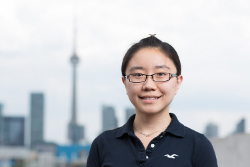 Tasnim Amerian
Tasnim Amerian
Tasnim joined SOCAAR during summer 2013, after completing her second year of Chemical Engineering. Her research focused on the investigation and characterization of the spatial gradients of ultrafine particle (UFP) distributions in the city of Toronto, particularly in highway-adjacent industrial, commercial, and residential zones. Her work involved collecting measurements from near-roadway zones in Toronto, quantifying background UFP particle number (PN) and mass concentrations, and creating a map representation of UFP variations around the city. She also explored relationships between fluctuations in UFP concentrations and traffic density, geographical locations and weather conditions. Through this experimental research, Tasnim has developed an interest in the field of air quality and its associated impacts on the environment, and hopes to continue her future studies in the field of environmental research and sustainable design.
 Siyan Guo
Siyan Guo
Siyan joined SOCAAR during summer 2013, after completing her second year of Chemical Engineering. Her summer research project focused on the validation of a near-real-time metals monitoring system by comparing with the gold standard ICP-AES (Inductively Coupled Plasma Atomic Emission Spectroscopy). Her work involved the collection and acid digestion of filter samples for metals analysis to validate the precision and accuracy of the Xact. She also modified the sample holder and the standard operating procedure of the Xact metals monitor to include filter based analysis. This modification would improve the measurement throughout the personal exposure experiments, which investigate the ability of metals to induce adverse health effects.
 Caitlin Maikawa
Caitlin Maikawa
Caitlin is in her second year of Chemical Engineering at the University of Toronto. She joined SOCAAR in summer 2013. Caitlin worked on analyzing the oxidative capacity of personal ambient particulate matter samples in asthmatic children. Her work involved analyzing antioxidant depletion in synthetic respiratory tract lining fluid when exposed to the particles collected in personal exposures by Health Canada. This work will help to characterize the health effects of 2.5 micrometer particulate matter exposure in asthmatics.
 Michael Murphy
Michael Murphy
Michael is in his second year of Engineering Science at the University of Toronto, and joined SOCAAR for the summer of 2013. His work primarily involved the computer automation of data analysis and acquisition tasks, such as implementing a real-time graphing system for air quality information, generating algorithms to efficiently classify particles by their composition and size, and writing software that adds direct-to-database logging capability to a number of instruments in the lab. His area of research concerned the correlation of high- and low-time resolution measurements from thermal and optical instruments, for the purpose of accurately quantifying the percentage composition of carbon particles at time resolutions much higher than current methods allow.
 Amanda Nowicki
Amanda Nowicki
Amanda joined SOCAAR in the summer of 2013, after finishing her second year of Chemical Engineering at the University of Toronto. She worked on creating new learning materials to efficiently convey the concepts covered in the Environmental Chemistry (CHE 230) curriculum. These deliverables were presented in both text and video format, in which she focused on explaining concepts which students had difficulty understanding. By delivering new resources to students, Amanda hopes to promote the importance of undergraduate engineering education, and help future CHE 230 students succeed.
 Scott Allan Orr
Scott Allan Orr
Scott is entering his fourth year of Chemical Engineering at the University of Toronto. He joined SOCAAR for the summer of 2013 and is continuing on to an undergraduate thesis with Professor Evans. His project developed and implemented a method of high-speed on-road measurements of particle numbers, size distributions, and black carbon concentrations, which was employed to sample a circular route of four Toronto highways. His research is concerned with the performance of mobile instruments in extreme meteorological and situational contexts, the urban spatial variability of ultrafine particles, and the development of land-use regression models. In the future, Scott hopes to examine the shift in air pollutant composition from traditional greenhouse gases to increased particular matter and bio-particulates, and the resultant effects on the aesthetic and structural properties of historic masonry.
 Anantha Valsalan
Anantha Valsalan
Anantha joined SOCAAR in the summer of 2013 after completing his 2nd year of Chemical Engineering at the University of Toronto. During the summer, he worked on quantifying the mass concentrations of fine particulate matter (PM2.5) emitted by both diesel and gasoline vehicles on College Street, observing diurnal trends and comparing weekday-weekend as well as seasonal variations in vehicular PM2.5 concentrations. This also involved the development of correction factors for an Optical Particle Sizer which would be used for future sampling with a collocated PM2.5 mass monitor. In addition, he was responsible for calibrating and evaluating the performance of a new traffic detection system implemented in the laboratory, as well as general maintenance of the sampling equipment.
